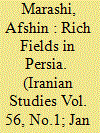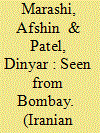|
|
|
Sort Order |
|
|
|
Items / Page
|
|
|
|
|
|
|
| Srl | Item |
| 1 |
ID:
189068


|
|
|
|
|
| Summary/Abstract |
This article investigates the history of economic relations between Iran and the Parsi community of India during the Reza Shah period. Encouraged by the policies of the new Pahlavi state, Parsi entrepreneurs began a serious effort to investigate the possibilities of economic investment in Iran. The article details three Parsi economic missions that were conducted in Iran during this period, and analyzes their assessments of Iran's potential for development in fields such as energy, textile manufacturing, commercial agriculture, and modern transportation systems. As the article argues, while these Parsi-led initiatives were part of a larger history of renewed engagement between Parsis and Iranians, for a variety of political and economic reasons, by the outbreak of World War II few of the Parsi plans for investment in Iran had come to fruition. While remaining largely forestalled in the interwar period, the article also suggests that Parsi economic assessments foreshadowed many of the planning strategies carried out in Iran's post–World War II history of economic development.
|
|
|
|
|
|
|
|
|
|
|
|
|
|
|
|
| 2 |
ID:
189070


|
|
|
|
|
| Summary/Abstract |
This photo essay provides a visual archive of Parsi philanthropic efforts toward the Iranian Zoroastrian communities of Yazd, Kerman, and Tehran during the 1930s. The essay reproduces a collection of photographs from a photo album produced by the Iranian Zoroastrian Anjoman (est. 1918) for the benefit of Parsi audiences in Bombay. These photographs were taken and compiled by administrators of the Parsi-funded charities in order to demonstrate to Bombay-based Parsi benefactors how their charity efforts were being used inside Iran. The essay also discusses the importance of including visual archival material as part of the social and cultural history of modern Iran, as well as the unique sets of challenges that such archival preservation represents.
|
|
|
|
|
|
|
|
|
|
|
|
|
|
|
|
| 3 |
ID:
189066


|
|
|
|
|
| Summary/Abstract |
A hundred years ago in colonial Bombay, on September 10, 1922, a group of Parsis established an organization called the Iran League. Meant to strengthen ties with their Iranian Zoroastrian coreligionists inside Iran, the Iran League also endeavored to recast wider economic and cultural relations between India and the country which Parsis regarded as their ancient homeland. That ancient homeland, after all, was undergoing seismic change. In the years following Reza Khan's 1921 coup and the establishment of the Pahlavi dynasty in 1925, Parsis watched with growing anticipation and excitement as Iran's new leader increasingly promoted a new national culture rooted in Iran's ancient past. Prominent Parsis, many of them leaders in the Iran League, fervently believed that Pahlavi Iran would herald all sorts of progressive change: improved conditions for the Iranian Zoroastrians, deeper appreciation of Zoroastrianism among Iran's Muslim majority, conditions for significant Parsi investment in Iran, and even the possibility of a mass Parsi “return” to the shah's domain, reversing the direction of centuries of Zoroastrian migration.
|
|
|
|
|
|
|
|
|
|
|
|
|
|
|
|
|
|
|
|
|